Posted by Elena del Valle on April 29, 2011
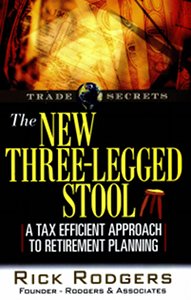
The New Three-Legged Stool book cover
Photos: News and Experts
Rick Rodgers, a certified financial planner and certified retirement counselor, believes the federal and state government is after your money. Well maybe not your money exactly but your retirement money as a part of a larger whole. He is optimistic that some simple adjustments will make it possible for tax payers to pay less in taxes in preparation for their retirement. In his 2009 book, The New Three-Legged Stool A Tax Efficient Approach to Retirement Planning (Marketplace Books, $24.95) he explains his reasoning.
“The IRS sees a huge amount of collective dollars, $17 trillion, to be exact, stashed away in IRAs and retirement savings,” said Rodgers. “This has caused the IRS to become very aggressive in taxing those assets. While you might not think the IRS is after your retirement money, they actually have a big red bull’s-eye painted on your retirement plan. As of September 2010, our country’s national debt totaled more than $13.5 trillion (and the number continues to rise by $2 million every minute!). That amounts to $121,600 of debt for each taxpayer in the United States. Yet this is a mere drop in the proverbial bucket compared to what the government will owe in benefits to Social Security and Medicare recipients far into the future, as well as in pensions to military and civilian government workers.”
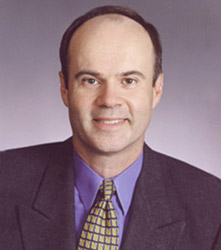
Author Rick Rodgers
The 202-page hard cover book is divided into an introduction and six chapters: Leg One: Tax-Deferred Savings Strategies; Leg Two: After-Tax Savings Strategies; Leg Three: Tax-Free Savings Strategies; Distributions: Strike an Ideal Balance Among All of Your Accounts; Understanding Social Security; and Keep the IRS Out of Your Estate.
The three legs of the stool are tax deferred strategies to save which addresses IRA accounts, 401 (k) and other tax deferred retirement vehicles; strategies to save after taxes which addresses asset allocation, risk reducing options and structuring investments in a tax efficient manner; and tax free strategies like the Roth IRA and Roth 401 (k) and ways to convert accounts into them.
Rodgers is an author, keynote speaker, wealth manager and president of Rodgers and Associates in Lancaster, Pennsylvania. His articles on retirement planning have appeared in Wealth Manager magazine, CPA Magazine and Physician’s Money Digest. He also writes a column for Lancaster County Magazine.
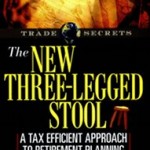
Click to buy The New Three-Legged Stool
Comments:
Filed Under: Books
Posted by Elena del Valle on April 27, 2011
By Catherine Lovell
Consumer behavior analyst
Varga Media Solutions

Catherine Lovell, consumer behavior analyst, Varga Media Solutions
Photo: Varga Media Solutions
The growth of the Hispanic market is certainly not a secret. In fact, this market is expected to account for nearly 11% of the nation’s total buying power by 2015 according to the Selig Center for Economic Growth. Many marketers have been anxiously awaiting the 2010 census results to assist in devising marketing plans that accommodate the emerging Hispanic market. What most of these marketers don’t realize is the data compiled by the census has never been more inadequate in pinpointing today’s Hispanic shopper.
In 2010 the U.S. Census Bureau sent out surveys by mail to households in order to estimate their base counts for the next decade. These counts rely upon each household accurately filling out a data questionnaire and then mailing it back to be compiled and modeled over the next ten years. Once the results are published, there are several data compilers who specialize in updating census data for small area geographies in between the 10 year census periods. These companies blend the census data with other inputs, using it to create estimates of consumer demand and segmentation, otherwise known as “modeled data”.
Click to read the entire article Don’t Rely on Census Bureau Survey Results to Drive Your Hispanic Targeting
Posted by Elena del Valle on April 25, 2011
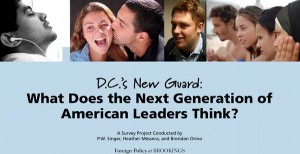
Photo: Brookings Institution
Although little information seems available about the attitudes and opinions of the up and coming generations, D.C.’s New Guard: What Does the Next Generation of American Leaders Think?, a 22-page report on the findings of a recent survey among youth with an interest in political careers, indicates this subgroup of the Millennial Generation, a large demographic group by all accounts, has its own characteristics and opinions as might be expected.
In terms of their political affiliations, 38.2 percent self identified as Democrats, 28.8 percent as Independents, and 26.4 percent as Republican. The profile is, according to the survey authors, different than the trends in the prior Generation X who grew up in the Reagan-era and exhibited more conservative attitudes than the Millennials. What the authors found most interesting was the large segment of youth leaders who remained unaffiliated with a political party even though many expressed views that might be associated with the Democratic point of view.
Want to target this group of leaders who may include future mayors, governors, and representatives through a news medium? Don’t try the evening news or late night comedy shows. While their responses to the survey indicate their source of news is traditional new organizations the evening news and late night comedy shows ranked low among them as a source of news. Thirty percent of Republican respondents preferred cable news to stay informed while Democrats and Independents consumed news from online news websites.
Who do they look up to when forming political opinions? Many of the respondents, 61 percent, said their parents were major influences. Political leaders accounted for 19 percent and media 12 percent. The survey authors concluded this aspect of the Millennials was quite different from the Baby Boomer Generation. When the Baby Boomers were young they tended to select a political view that was the opposite of that of their parents’. Celebrities and faith leaders had a relatively low political influence level among young Millennial leaders.
Assuming that the models young people admire today may influence their attitudes tomorrow, the survey authors asked what leaders from history they admired. More than one third (under 36 percent) chose a military leader or civilian leader closely associated with wartime like Franklin Delano Roosevelt, Abraham Lincoln, Dwight Eisenhower and Woodrow Wilson. The survey authors believe that is not surprising given that the United States the respondents have known to date has been at war for a majority of their lives. Fourteen percent admired a founding father such as Thomas Jefferson, James Monroe and Alexander Hamilton while 10 percent chose leaders of social change such as Martin Luther King, Jr. and Nelson Mandela. About one percent chose a religious figure such as Mother Theresa or the Prophet Mohammed as a leadership model for the 21st century.
When asked about a leader today that they admired more than 49 percent said Barack Obama, well past any other leader named. The political affiliations of those who preferred Obama as their “ideal leadership model,” were 62.8 percent Democrats, 28.5 percent Independents and 8.7 percent Republicans. Other listed as models who received between one and five percent included John McCain (with 5.5 percent favoring him as their model leader), Al Gore, Bill Clinton, Colin Powell, Condoleezza Rice, Nelson Mandela and Hillary Clinton.
Although the survey authors did not ask about the ethnicity or cultural background of respondents (or did not share the information in the report), it is safe, based on the degree of diversity among American youth revealed by 2010 Census, to assume some degree of diversity among the respondents. It is unclear from their findings exactly what affiliations and opinions Hispanics, African Americans, Asians and others in this group of leaders may have. Now that this youth demographic group has been identified as worth watching maybe future surveys and research will reveal more about the leadership attitudes of the Millennial Generation and its diverse market segments.
The survey, published on the Brookings Institution website in February 2011, was conducted among 1,057 young American leaders who were attendees at the National Student Leadership Conference, as well as the Americans for Informed Democracy young leaders’ courses, and DC internship programs by P.W. Singer, Heather Messera, and Brendan Orino. The respondents were 16 plus years old on average, 45 percent women and 55 percent men. The largest geographic representation was 34.6 percent from the Mid-Atlantic region followed by 15 percent from the South, 14 percent from the Pacific, 13 percent from the Midwest, 12.1 percent from New England, 8.7 percent from the Southwest, and 2.6 percent from the West. The northeast was overrepresented while the rest of the country was underrepresented according to the survey authors.
Posted by Elena del Valle on April 22, 2011

The Animalitos Exploradores team members – click to enlarge
Photo: Vme
The National Wildlife Federation(NWF) and Vme want Spanish speaking children to appreciate nature. In an effort to reach Hispanic preschoolers and their families the television network and the not for profit organization have teamed up to launch a TV series in Spanish scheduled to premiere today.
Animalitos Exploradores (Wild Animal Baby Explorers) will air daily at 8:45 a.m. during the Vme Niños block of programming for children that airs between 7:30 a.m. and 12:30 p.m. (ET) and the 24/7 cable channel Vme Kids. Eighty segments have been dubbed into Spanish from the original English language 15 minute episodes.
Based on NWF’s preschool magazine, Wild Animal Baby, the show is a combination of 3D animated characters and high-definition live-action footage. The program features five intrepid wildlife characters and an NSI (Natural Science Investigator) unit while they explore the natural world around them. According to promotional materials, Animalitos Exploradores showcases young children and families engaging in simple and easily executable outdoor activities designed to teach them to appreciate nature.
“With Animalitos Exploradores, as in everything we do, NWF is committed to making learning fun for kids while instilling in them a lifelong respect for wildlife and the environment,” said Tony Summers, director, Production of NWF.

Guillermo Sierra, senior vice president, Vme
“Animalitos Exploradores fosters early nature exploration and helps preschoolers understand the world around them,” said Guillermo Sierra, senior vice president of programming at Vme. “By bringing Wild Animal Baby Explorers to Vme, we are able to expose young viewers to the beauties of the natural world and foster a respect for nature that lasts them a lifetime.”
The Animalitos Exploradores are Benita The Beaver, described as seeing beauty in all things, eager, warmhearted, and a tactile learner; Skip The Rabbit described as the group leader and a logical thinker; Izzy The Owl, described as plucky and curious; Sammy The Skunk, described as the youngest member of the group who loves to hide, is unabashedly silly and serves as the eyes, ears and attitude of the show’s young viewers; and Miss Sally The Salamander, described as the oldest in the group and the big sister who uses her knowledge and teaching skills to keep everyone on track.
The National Wildlife Federation is one of the nation’s largest conservation organizations with four million members and supporters. The group strives to connect people with nature, and inspiring Americans to protect wildlife for our children’s future.” Vme (pronounced veh-meh) is a national Spanish-language television network presented by public television stations. The 24-hour Spanish network available in 10 million homes, offers drama, music, sports, news, current affairs, Latin cinema, food, lifestyle, nature and educational preschool content.
Posted by Elena del Valle on April 21, 2011
Information provided by Event Partner
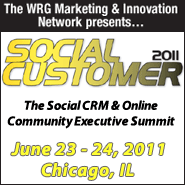
Social Customer 2011
The Social CRM & Online Community Executive Summit
June 23-24, 2011
Wyndham Blake Chicago, Chicago, IL
Hispanic MPR subscribers qualify for a special discount for Social Customer 2011.
As social media becomes a major facet of customer’s lives, top brands across industries are realizing the growing need to listen to what their customers are saying on the social media channels, develop interactive online customer communities and meet their needs through smarter initiatives
This executive summit will help you:
ANTICIPATE customer concerns through smarter social media monitoring
ACCELERATE online community growth through better content strategies
ATTAIN internal organizational program support & involvement from the top down
ARTICULATE the best strategy for scaling programs to meet customer needs
ANALYZE program results to develop effective metrics for success measurement
ACHIEVE greater success in leveraging social media to drive customer loyalty & true brand engagement
Details and registration are at www.worldrg.com/socialcustomer. Hispanic MPR subscribers should enter the Promo Code “TPR673” for $200 off the registration rate. To register, please call 800-647-7600 or register online at www.worldrg.com/socialcustomer. For sponsorship opportunities contact Mark Coulter, 646-723-8049, mark.coulter@worldrg.com.
Posted by Elena del Valle on April 20, 2011
By Eric Granof
Chief marketing officer
ExpertBail

Eric Granof, chief marketing officer, ExpertBail
Photos and video: ExpertBail
Building a brand is never an easy challenge, but doing so in the context of an industry that already has a negative image, can be nothing short of daunting. Add to this, an extremely popular television program that supports the negative stereotype and even worse, a long history of Hollywood romanticizing and perpetuating the negative stereotype of your industry and you can begin to see the complexity and magnitude of the challenge that our team at AIA, the nation’s largest underwriter of bail bonds, was faced with only 7 short months ago when we launched ExpertBail.
The bail bond industry is a very interesting one. Not only has it been misrepresented by the media, but it is also extremely misunderstood by the average person on the street. This is probably due to the fact that most people don’t ever expect or plan on needing a bail bond. So when they do need one, the experience is preceded with fear and uncertainty. We felt it was time to eliminate those negative feelings and replace them with new ones of trust, hope and confidence.
Click to read the entire article With video – Building a Brand and Breaking a Stereotype
Posted by Elena del Valle on April 19, 2011
Information provided by Event Partner

B2B Digital Marketing 2011
The Premiere B2B Digital Executive Marketing Event
July 27-28, 2011
Holiday Inn Chicago Mart Plaza, Chicago, IL
Hispanic MPR subscribers qualify for a special discount for B2B Digital Marketing 2011.
B2B Digital Marketing 2011 is the first event of it’s kind to bring B2B corporations from across industries together to discuss the newest strategies, techniques, and tools to drive renewed growth and profitability through smart online search, social, and email techniques. As the use of new online marketing and mobile tools are becoming more and more prevalent in the B2B sector, corporate executives are feeling pressured, more than ever, to put together a coherent digital plan. With a focus on new technology and social channels, participants take part in a value-packed, interactive and inspiring event that will take the conversation to the next level and give actionable strategies to strengthen relationship and CAPTURE new business.
Experiences from leading B2B Corporations:
Aon
AT&T
Bloomberg
Google
IBM
FedEx
Xerox
…and many others
Details and registration are at http://worldrg.com/showConference.cfm?confCode=MW11010. Hispanic MPR subscribers should enter the Promo Code “UAZ296” for $200 off the registration rate. To register, please call 800-647-7600 or register online at http://worldrg.com/showConference.cfm?confCode=MW11010. For sponsorship opportunities contact Mark Coulter, 646-723-8049, mark.coulter@worldrg.com.
Posted by Elena del Valle on April 18, 2011

Paulina Abascal, host, Pastelería.mx
Photos: Vme
Vme boasts about its Spanish language cooking block in Vme Cocina which accounts for 5 percent of its overall programming. Earlier this month Vme announced a new schedule starting at 12:30 p.m. Features in the daily two hour block Sunday to Friday showcase the knowledge and styles of chefs from varied countries including Colombia, Mexico, Spain and Venezuela. Vme hosts the block of programs call Vme Cocina and produces the interstitials. The programs within the block, 12 hours per week, come from its production partners, elgourment.com, Scripts and Localia.
In Nuevos Sabores (Spanish for new flavors) shot in Mexico Isabella Dorantes and Gerardo Rivera, two young Mexican chefs, share cooking advice from their home kitchen. Chef Alfredo Oropeza of Más Sabor en Menos Tiempo (Spanish for more flavor in less time) demonstrates how to prepare quality recipes quickly at home for those on a budget. Orígenes con Catalina Vélez, a Colombian chef, prepares Colombian food, with grocery store and Colombian products.
In Puro Sumo, Sumito Estévez, a Venezuelan chef, mixes Venezuelan dishes and Asian styles and strives for a “modern and uniquely international” cuisine. Estévez also presents Sumo Placer dedicated to Venezuelan cuisine.

Chef Sumito Estevez, host, Puro Sumo
Cocinando con Fernando Canales is hosted by Fernando Canales, a restaurateur from Bilbao. During the program, he presents his best recipes and practical tricks to help home cooks; shares advice on buying the best groceries and provides dietary and nutrition tips, and recipes for children.
In Gourmet Light, Enrique Fleischmann, a Mexican chef, offers ideas for healthy, delicious dishes with an eye on the waist line. For chocolate lovers there is El Cacao hosted by Mexican José Ramón Castillo.
During Donato Cucina, Donato De Santis, an Italian chef, shares recipes from the diverse regions of his home country. Paulina Abascal spends time sharing baking advice, and Mexican pastry recipes with viewers in Pastelería.mx.
Vme (pronounced veh-meh) is a national Spanish-language television network presented by public television stations. The 24-hour Spanish network available in 10 million homes, offers drama, music, sports, news, current affairs, Latin cinema, food, lifestyle, nature and educational preschool content.
Vme, the first venture of the media production and distribution company, Vme Media Inc., is available free over-the-air, on basic digital cable, nationally via satellite in the basic and Hispanic packages of Dish Network and DirecTV and, in some areas, on Verizon FiOS and AT&T U-verse.
Posted by Elena del Valle on April 15, 2011
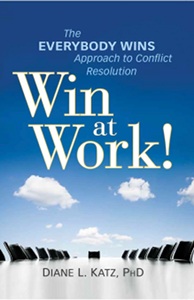
Win at Work book cover
Photos: The Working Circle Teambuilding, Inc.
Diane Katz, Ph.D. offers organizational, development, human resources and coaching consulting services to clients in the services, construction, technology, health care and not for profit sectors. Over the years she has identified some of the methods that in her experience address conflict resolution effectively in the workplace. In 2010, she gathered her most successful workplace conflict resolution and negotiation strategies into a manual of ideas and communications tactics with the goal of helping people achieve win-win solutions to troublesome issues at work.
In Win at Work The Everybody Wins Approach to Conflict Resolution (Wiley, $24.95), a 237-page hardcover book, she outlines The Working Circle, her eight-step process for conflict resolution which encourages an objective, non-combative approach. She begins by explaining her belief that conflict is not inherently good or bad although there is constructive and destructive conflict.
According to Katz, constructive conflict promotes creativity, innovation, betterment, and problem solving attitudes; while destructive conflict may lead to inconsistent organizational goals, many employees pursuing personal goals, deception and inefficient management overall.
The book is divided into twelve chapters and three parts, What is the Working Circle, Understanding Conflict Resolution and From the Working Circle to the Winners Circle.

Author Diane Katz, Ph.D.
The process she supports includes determining what is negotiable and what is not, developing a game plan, and communicating the positive changes that may result. She believes it is important to blend intuition and intellect. In the book, she relies on past experiences from her practice to illustrate possible situations the reader may face; and to solve common challenges like asking for and justifying a raise, dealing with a disruptive business partner, whether to speak up or remain silent about a situation taking place at work, whether to take sides or mediate, dealing with a client’s anger, negotiating independence from a micromanaging boss, standing up to a workplace bully, and managing a troublemaker.
Katz, a Tucson, Arizona based organization consultant and the president of The Working Circle Teambuilding, Inc., has a doctorate degree in Conflict Resolution from Union Institute. Previously she was a human resources executive at American Express, Chase Bank, KPMG Peat Marwick, and Alexander & Alexander.

Click to buy Win at Work!
Comments:
Filed Under: Books
Posted by Elena del Valle on April 13, 2011

Juan Carlos López of CNN en Español
Photo: CNN en Español
Starting this week CNN en Español is offering special coverage from Havana, Cuba. Cuba en la Encrucijada (Cuba at the Crossroads), hosted by Juan Carlos López, is scheduled to air April 14 to April 20. As part of the coverage López plans to keep the audience informed on the Sixth Congress of the Cuban Communist Party taking place between April 16 and April 19, 2011. The purpose of the event is to draft the guidelines for the economic and social policy of the country. López will report live for several of the network’s programs, Encuentro, NotiMujer, Directo USA, Panorama Mundial, Café CNN and Conclusiones.
On Thursday April 14, from 9 to 10 p.m.(ET), Patricia Janiot, Fernando del Rincón, Claudia Palacios, Camilo Egaña and Juan Carlos Lopez from the network and guests from Havana are expected to offer analysis of the Sixth Congress of the Cuban Communist Party and its potential effects on Cuba and other countries in the region. They also plan to elaborate on the 50 anniversary of the proclamation of the socialist character of the Cuban revolution and its effects on Latin America and the world.
Anchor Ismael Cala is scheduled dedicate the Friday, April 15 edition of Cala at 9 p.m. (ET) to a special program named Playa Girón during which he is scheduled to interview Alfredo Durán, one of the young men trapped on the beaches of the Bay of Pigs, who revisited Cuba ten years ago for the 40 anniversary of the invasion. Plans are in place for a local guest to join the conversation, the person from Havana, Cuba who confronted Durán on the opposite side of the invasion fifty years ago. Together they are expected to analyze the invasion and its impact fifty years later.
According to a network spokesperson CNN en Español has had a news bureau in Cuba for years. López, who has been a reporter with CNN since 1993, is the head of the Washington D.C. bureau for CNN en Español. Prior to working with CNN he worked with CNN International and WLTV Channel 23. A native of Bogota, Colombia, he is a journalism graduate of the Universidad Javeriana in that city.
Comments:
Filed Under: Media

























